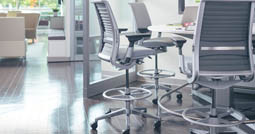Sit Tall in the Saddle: Drafting Chairs
Posted by Human Solution on Oct 19th 2010

Height is a powerful element in ergonomics. Such factors as how high your work surface is in relation to your seat, how high your arms must be positioned and whether your feet touch the floor in your chair are all critical to maintaining proper posture and reducing pain. For users who wish to sit at a drafting table or standing height desk, an ergonomic drafting chair helps them maintain all the correct relative heights.
A drafting chair is essentially a normal ergonomic chair with a couple modifications:
- The cylinder is elongated, meaning the seat is higher than normal, often topping out above 30”. Compare that to a maximum seat height around 22” in most office chairs.
- As the seat is so high that no one’s feet could touch the ground while seated, there is usually an elevated foot ring to rest them on.
While they serve their purpose, a drafting chair is not for everyone. People seated at normal-height desks are usually not advised to get drafting chairs. They often initially want one because the surface of the desk is too high, making them place their arms at odd angles to use their keyboard and mouse. While a drafting chair might solve this problem, it will almost certainly create the problem of making their legs unable to fit under the desk. These people are better advised to look at an adjustable keyboard tray like the Workrite Banana Board or possibly look into an adjustable-height desk such as the Sis Move!. The Move! is a sit-stand workstation, meaning it can actually be positioned to fit a drafting chair as well.
In addition to a height-adjustable desk, the other main users of drafting chairs are people working at drafting tables and fixed standing-height desks. For these users, a good ergonomic drafting chair can work great.




